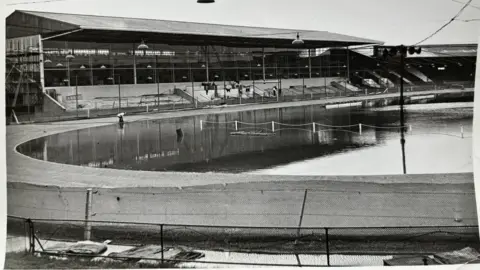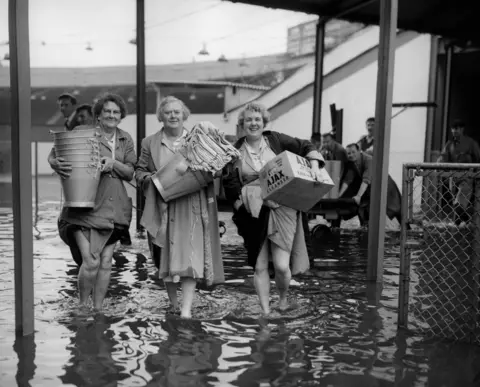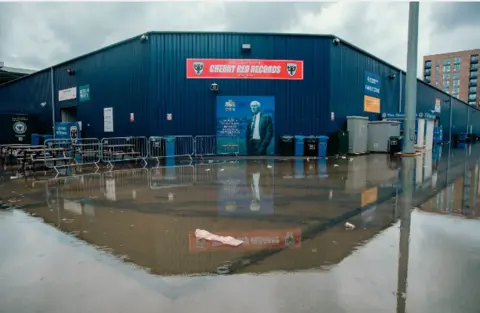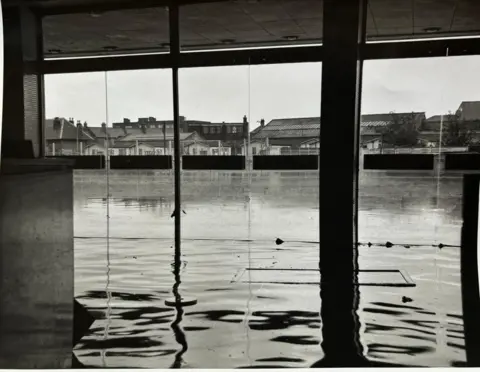ARTICLE AD BOX

 The Dons Den
The Dons Den
In the 1950s, flooding was common at the site of AFC Wimbledon's current stadium. The old venue was demolished in 2018, with the football club's new ground built on the same site
The flooding of AFC Wimbledon's football ground was "totally predictable", a campaign group has said.
More than 100,000 litres of water was pumped from the Cherry Red Records Stadium after drains backed up overnight on 22 September.
Michael Burnage, of the Save Wimbledon Stadium Action Group, told the BBC: "We all knew that it was just a matter of time. The question in our mind was not if there would be a flood on the site, but when it would happen."
The Environment Agency said planning decisions were made by local authorities. Merton Council, which was responsible for the decision to approve the new stadium, said it was "sad to see the damage and disruption caused by flooding".

 PA Media
PA Media
In 1957, the previous stadium's catering staff had to wade through floodwater to access the ground
Two home matches - including a League Cup tie with Newcastle United - were postponed after the pitch collapsed following the latest flood. The first match back at the ground since the flooding will be against Carlisle United on Saturday.
The previous stadium, which opened in 1928, hosted greyhound racing until its closure in 2017 - which was described at the time as a "crime against happiness" by the Racing Post.
It also hosted stock car racing and speedway events, which ceased in 2005.
Mr Burnage, whose group campaigned against the 2018 demolition of the stadium, said the area had flooded many times throughout its history.
Drone video shows collapsed pitch at AFC Wimbledon
He said: "Our campaign group have not been in the least surprised that the new stadium has seen such devastating flood damage.
"We have every sympathy for the staff and officials of AFC Wimbledon having to deal with the impact of this latest flood, but to say it was unpredictable is simply not true.
"As part of our campaign, we highlighted our years of experience on the site, recalling the countless times that the stadium and the car park were flooded."
He said that developers, the council, City Hall and the Environment Agency were all warned about the dangers of future flooding, adding: "We are incredibly frustrated by recent events."

 BBC/Harry Low
BBC/Harry Low
AFC Wimbledon's Cherry Red Records Stadium opened in 2020

 AFC Wimbledon
AFC Wimbledon
The flooding it experienced last month was foreseen by some
More than £120,000 has been raised by the fan-owned club following the latest flooding.
Wimbledon FC left its original home at nearby Plough Lane in 1991 because legislation required all-seater stadiums.
Following a spell playing at Crystal Palace's Selhurst Park, in 2004 the club was controversially rebranded as MK Dons after the owners moved it to Milton Keynes.
AFC Wimbledon was set up in 2002 as a non-league club, winning five promotions in nine years to rise from the depths of the Combined Counties League to reach the Football League in 2011.
During that time, the club played home matches at Kingsmeadow - which is now the home of Chelsea FC Women - before the move to the Cherry Red Records Stadium in November 2020.

 The Dons Den
The Dons Den
Stadium promoter Ronnie Greene pulls a trolley through floodwater with Cyril Brine on his speedway bike

 The Dons Den
The Dons Den
In 1968 the old stadium suffered one its many floods, when the nearby River Wandle burst its banks
Jon Stevens, a curator of the Dons Den, which is home to many items from the previous stadium's Speedway heyday, says "historically, it's always flooded".
He told BBC London: "It's been well documented that it's flooded quite substantially.
"Regarding building a brand-new stadium and it still flooding, I guess maybe something’s been overlooked.
"I don’t know why they did that: that’s the million dollar question.
"Were there enough measures in place to combat any potential flood?"
Aaron Paul speaks to AFC Wimbledon's managing director James Woodroof
An Environment Agency spokesperson said: "As the stadium is a brownfield redevelopment in a high-risk flood zone, its planning involved lengthy discussions, mapping and reports on how the flood risk would be managed.
"We originally objected to the proposed development due to insufficient information. Once this had been supplied, we were able to remove our objection and requested several planning conditions."
A Merton Council spokesperson said: "The stadium is built on previously developed land with a historic risk of flooding, a risk common across many developed areas of London.
“Given this risk, and the increase in flash flooding caused by our changing climate, the planning proposal was, like all proposals, examined rigorously.
"The council’s planning committee and the Environment Agency sought to ensure the stadium would remain safe, that the building would not increase risk of flooding nearby, including to homes, and that damage mitigation and recovery plans were thorough and robust.
“We are working closely with the Environment Agency and AFC Wimbledon to manage the risk of flooding, and to support in the review of the club's flooding processes.”

 1 month ago
10
1 month ago
10








 English (US)
English (US)